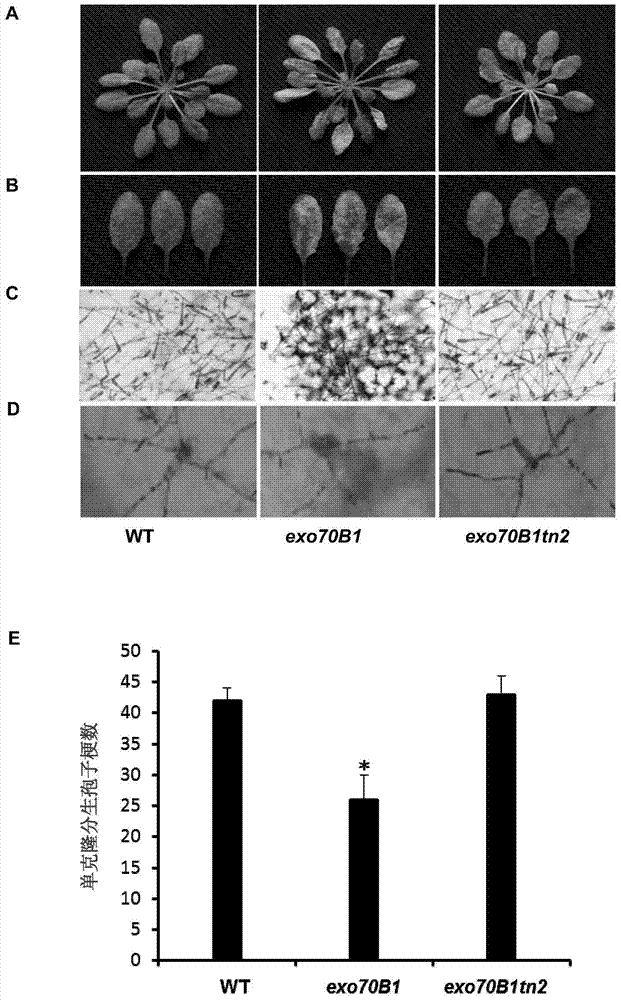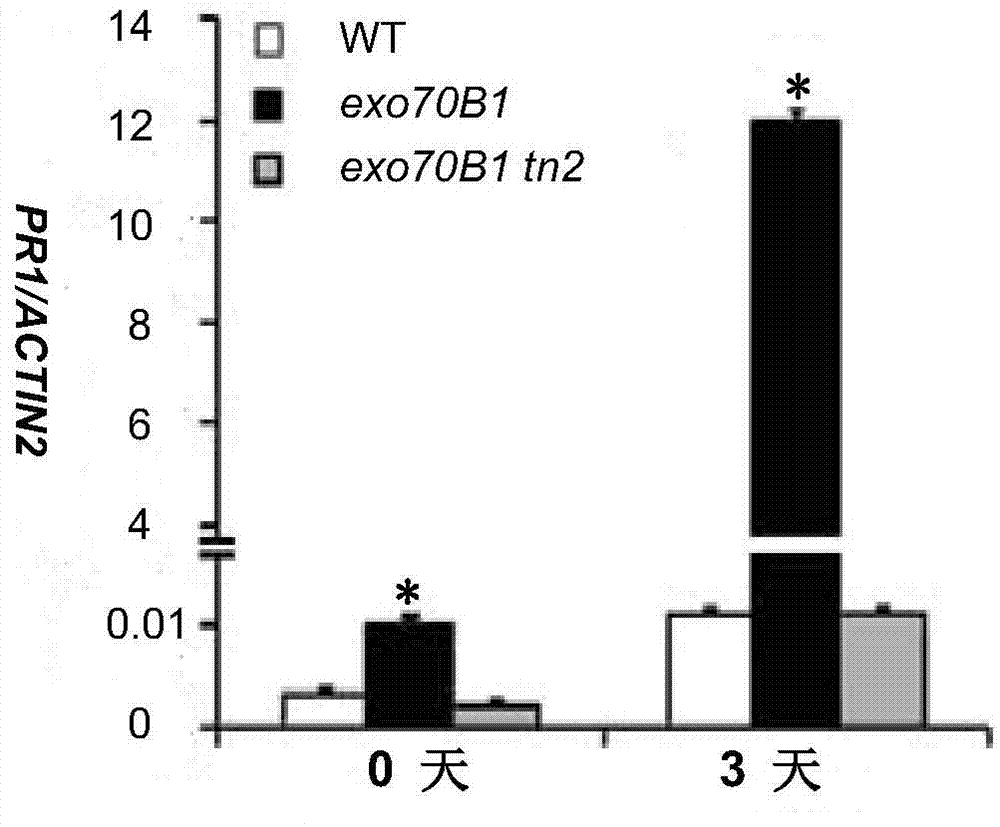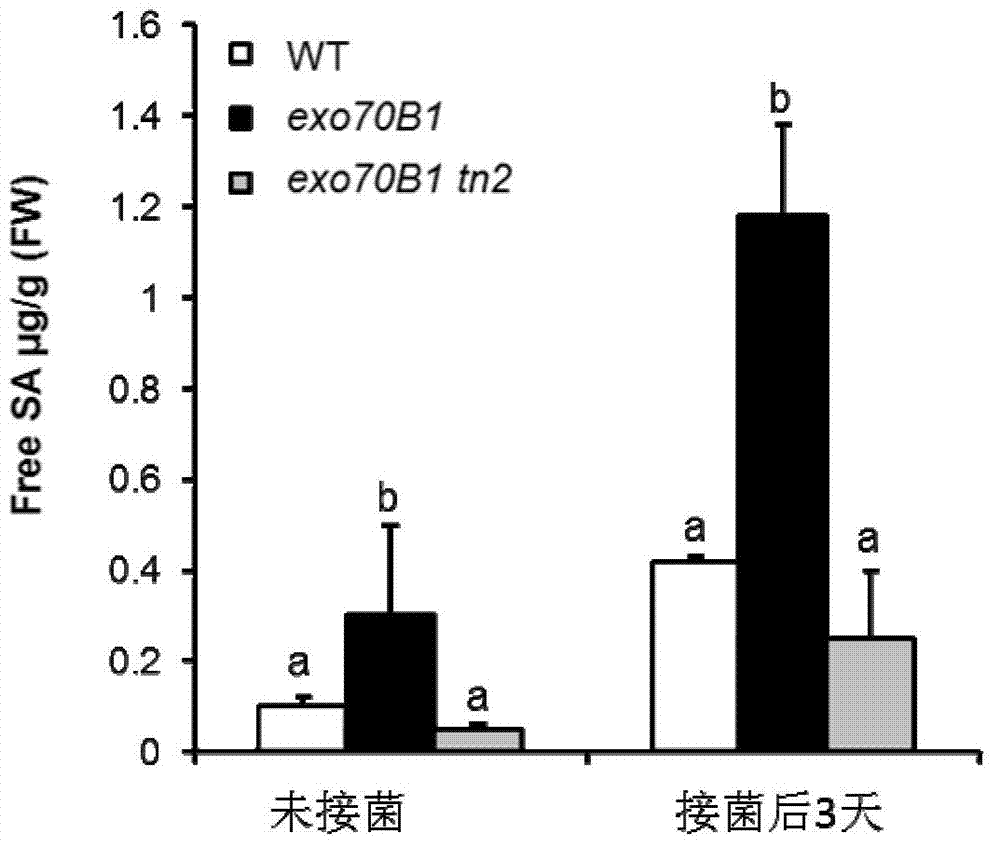Cloning and application of R gene TN2 for regulating and controlling powdery mildew resistance of plants
A powdery mildew, plant technology, applied in the direction of plant genetic improvement, application, plant peptides, etc., can solve problems such as infection and economic losses in agricultural production
- Summary
- Abstract
- Description
- Claims
- Application Information
AI Technical Summary
Problems solved by technology
Method used
Image
Examples
Embodiment 1
[0051] Embodiment 1, TN2 mutation inhibits exo70B1 mutant powdery mildew resistance
[0052] 1. Obtaining of mutant exo70B1tn2
[0053] A mutant library of exo70B1 was obtained by EMS mutagenesis. In the M2 generation, a mutant exo70B1tn2 that can inhibit exo70B1-mediated powdery mildew resistance was screened.
[0054] The mutant exo70B1tn2 can also be prepared according to the following method: the mutant exo70B1 (N717829) is crossed with the mutant tn2 to obtain a hybrid F1 generation, and the homozygous double mutant exo70B1tn2 can be obtained by screening the F2 generation obtained by selfing of the F1 generation.
[0055] Wild-type Arabidopsis Col-0 (hereinafter referred to as wild-type Arabidopsis), recorded in the following documents: Catherine A.Frye, Dingzhong Tang, and Roger W.Innes (2001).Negative regulation of defense responses in plants by a conserved MAPKK kinase. PNAS 98(1):373-378; publicly available from Institute of Genetics and Developmental Biology, Chin...
Embodiment 2
[0069] Example 2, TN2 mutation inhibits the expression of PR1 gene (AY064023, submitted on November 19, 2001) in exo70B1 mutant
[0070] In order to verify whether the TN2 gene is involved in plant disease resistance, real-time quantitative PCR was used to detect the expression patterns of PR1 gene in Col-0, mutant exo70B1 and double mutant exo70B1tn2 before and after inoculation with powdery mildew. The instrument used is Germany Eppendorf Mastercyclereprealplex 4S, details are as follows:
[0071] Arabidopsis wild-type plants Col-0(WT), mutant exo70B1 and double mutant exo70B1tn2 grown for 4 weeks were inoculated with powdery mildew for 3 days, and the leaves of the uninoculated and 3-day-inoculated plants were taken respectively and put into the liquid Quick-frozen in nitrogen, then stored at -70°C, and extracted RNA for later use.
[0072] The total RNA of leaves was extracted with Trizol (Invitrogen) reagent, the contaminated DNA was digested with DNase I (Promega) for h...
Embodiment 3
[0075] Example 3, TN2 mutation inhibits the accumulation of free salicylic acid in the exo70B1 mutant
[0076] Salicylic acid is a central molecule regulating plant disease resistance. Salicylate-dependent signaling is critical for the establishment of local and systemic resistance in plants. The content of free salicylic acid in Col-0, mutant exo70B1 and double mutant exo70B1tn2 before and after inoculation with powdery mildew was detected.
[0077] Seedlings of Arabidopsis wild-type plant Col-0 (WT), mutant exo70B1 and double mutant exo70B1tn2 were inoculated with powdery mildew in large quantities. The leaves of each material were quick-frozen in liquid nitrogen, and then stored at -70°C to extract salicylic acid for later use.
[0078]The content of salicylic acid was determined by high performance liquid chromatography, and the method described in the literature Xin Li, Yuelin Zhang, Joseph D Clarke, Yan Li, Xinnian Dong (1999) Identification and cloning of a negative r...
PUM
 Login to View More
Login to View More Abstract
Description
Claims
Application Information
 Login to View More
Login to View More - R&D
- Intellectual Property
- Life Sciences
- Materials
- Tech Scout
- Unparalleled Data Quality
- Higher Quality Content
- 60% Fewer Hallucinations
Browse by: Latest US Patents, China's latest patents, Technical Efficacy Thesaurus, Application Domain, Technology Topic, Popular Technical Reports.
© 2025 PatSnap. All rights reserved.Legal|Privacy policy|Modern Slavery Act Transparency Statement|Sitemap|About US| Contact US: help@patsnap.com



